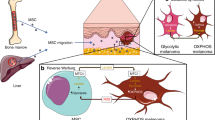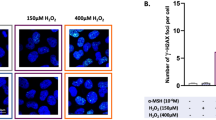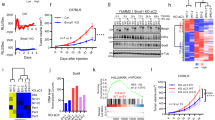Abstract
WE have recently described a mouse melanoma cell line which responds to melanocyte stimulating hormone (MSH) with dramatic increases in tyrosinase activity and melanin content, as well as changes in cellular morphology and growth characteristics1–3. The increase in pigmentation following exposure to MSH is shown in Fig. 1. Cyclic AMP or dibutyryl cyclic AMP may be substituted for MSH in eliciting these responses; consistent with other work suggesting that MSH acts through cyclic AMP in the control of pigmentation in vertebrates4–7. In our previous studies we used non-synchronised mouse melanoma cells grown in monolayer culture. Martin et al.8 have shown that synchronised mouse HTC cells respond to corticosteroids with increased tyrosine amino transferase synthesis in the late Gl and early S periods of the cell cycle; similarly, Buell and Fahey9 have shown, using a synchronised human lymphoid cell line, that immunoglobulins G and M are expressed in late Gl and S. We wished to investigate the effects of MSH on tyrosinase activity and endogenous cyclic AMP levels in synchronised cells to determine if there is a particular hormone-sensitive phase of the melanoma cell cycle. We report here that melanoma cells responded maximally to MSH with increased tyrosinase activity and cyclic AMP content during the G2 phase.
This is a preview of subscription content, access via your institution
Access options
Subscribe to this journal
Receive 51 print issues and online access
$199.00 per year
only $3.90 per issue
Buy this article
- Purchase on SpringerLink
- Instant access to full article PDF
Prices may be subject to local taxes which are calculated during checkout
Similar content being viewed by others
References
Wong, G., and Pawelek, J., J. cell Biol., 55, 288 (1972).
Wong, G., and Pawelek, J., Nature new Biol., 241, 213 (1973).
Pawelek, J., Wong, G., Sansone, M., and Morowitz, J., Yale J. Biol. Med., 46, 430–443 (1973).
Bitensky, M. W., and Demopoulos, H. B., J. invest. Derm., 54, 83 (1970).
Chen, S., Tchen, T. T., and Taylor, J., Pigment Cell 1, 1 (1973).
Johnson, G. S., and Pastan, I., Nature new Biol., 237, 267 (1972).
Kreider, J. W., Rosenthal, M., and Lengle, N., J. natn. Cancer Inst. 50, 555 (1973).
Martin, D., Tomkins, G. M., and Granner, D., Proc. natn. Acad. Sci., U.S.A., 62, 248 (1969).
Buell, D. N., and Fahey, J. L., Science, 164, 1524 (1969).
Brown, B. L., Albano, J. D. M., Ekins, R. P., and Sgherzi, A. M., Biochem. J., 121, 561 (1971).
Varga, J. M., DiPasquale, A., McGuire, J. S., Lerner, A. B., and Pawelek, J., Proc. natn. Acad. Sci. U.S.A. (in the press).
Author information
Authors and Affiliations
Rights and permissions
About this article
Cite this article
WONG, G., PAWELEK, J., SANSONE, M. et al. Response of mouse melanoma cells to melanocyte stimulating hormone. Nature 248, 351–354 (1974). https://doi.org/10.1038/248351a0
Received:
Revised:
Published:
Issue date:
DOI: https://doi.org/10.1038/248351a0
This article is cited by
-
Ultraviolet radiation and cutaneous malignant melanoma
Oncogene (2003)
-
Different growth responses to agents which elevate cAMP in human melanoma cell lines of high and low experimental metastatic capacity
Clinical & Experimental Metastasis (1989)



